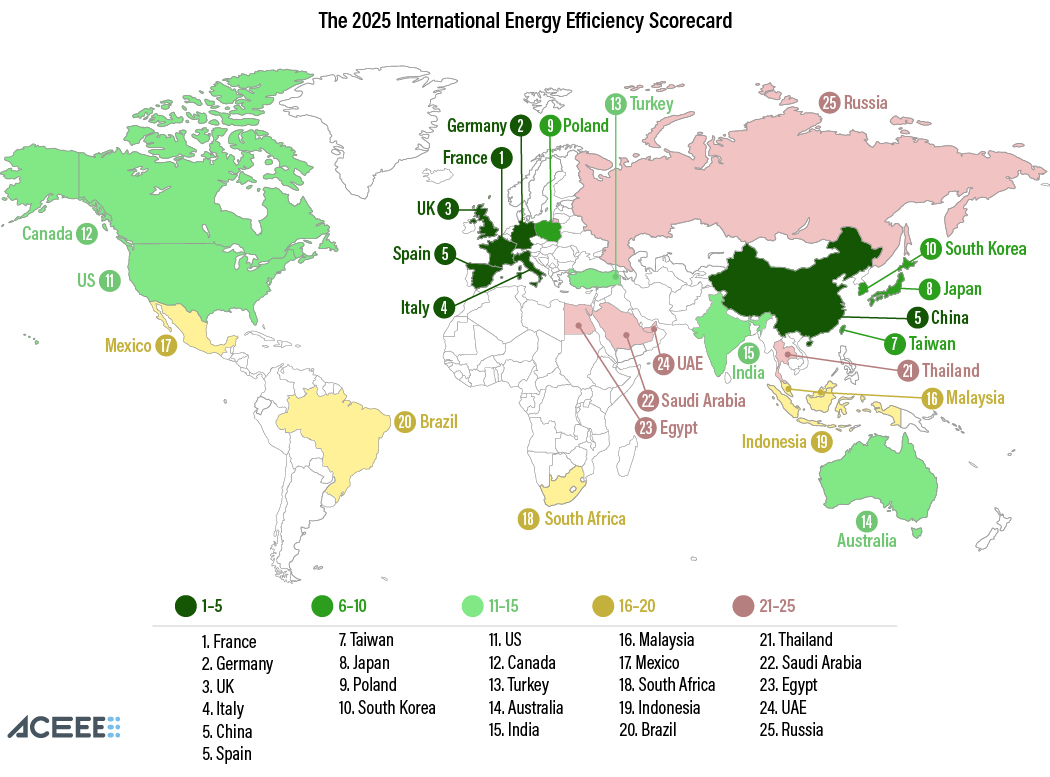Key FindingsThe ACEEE International Energy Efficiency Scorecard ranks the top 25 highest energy-consuming countries on their energy efficiency policies and performance.
|
Energy efficiency is a necessary strategy for fighting climate change and is "the one energy resource that all countries possess in abundance." Saving energy can reduce air pollution and greenhouse gas (GHG) emissions from energy generation; it can also reduce energy bills and make energy systems more resilient during extreme weather events. Thus, improving energy efficiency is beneficial for affordability as well as for climate change mitigation and adaptation.
Countries have multiple opportunities to advance energy efficiency at the national level as well as in the buildings, industry, and transportation sectors. They can pass policies to require energy-efficient products and processes, and they can track progress on energy performance. Making such data publicly available can help policymakers understand areas for future improvement.
National lockdowns and pauses in economic activity from the COVID-19 pandemic resulted in significant reductions in energy consumption in the early 2020s. However, such disruptions are not sustainable or effective for achieving long-term energy savings. Instead, countries should invest in programs, research, and infrastructure that promote energy-efficient operations. Specifically, countries should work to reduce national energy intensity (i.e., a country’s total energy consumption per unit of economic output). Nationally, Egypt achieved a commendable 46.18% reduction in national energy intensity between 2017 and 2022.
Overall, countries varied greatly in their efforts to reduce energy intensity across different sectors. The buildings sector measured energy intensity from both residential and commercial (i.e., nonresidential) buildings. For residential buildings, energy intensity can be measured as energy use per residential floor area or as energy use per capita. For commercial buildings, energy intensity can be measured as energy use per commercial floor area or as energy use per gross domestic product (GDP). Latin American countries such as Brazil and Mexico reported low energy use intensity (EUI) from both residential and commercial buildings.
We also evaluated the energy intensity of each country’s broad industrial sector (measured as energy intensity of industry based on consumed energy per dollar of industrial GDP) and agricultural sector (measured as kilograms of oil equivalent per dollar of agricultural GDP). Many European countries, including the United Kingdom, Germany, Italy, and France, reported low energy intensity from the broad industrial sector, while Asian countries such as China, India, Indonesia, Malaysia, and Thailand achieved low energy intensity in the agricultural sector. This diverse range of high performers shows that any country can make energy intensity improvements regardless of geography, income levels, or other distinguishing factors.
Most countries scored highly in the buildings chapter, but even the top-ranked nations could do more to strengthen the energy performance of new and existing buildings. Building retrofit policies can help existing residential and commercial (i.e., nonresidential) buildings lower energy costs and GHG emissions simultaneously. However, only four countries (France, Germany, Italy, and the United Kingdom) have robust policies for whole-building retrofits and offer financial incentives to encourage retrofitting. Further, only six countries (France, Germany, Japan, Saudi Arabia, South Africa, and the United Kingdom) have mandatory national codes for residential and commercial buildings that require minimum standards for insulation, window efficiency, air sealing, efficient lighting, efficient heating and cooling systems, and efficient water heating. We urge more nations to set higher energy performance standards for new and existing buildings to help residents save money and live more comfortably while cutting climate pollution.
Notably, the transportation sector is one area in which all countries need to maximize efficiency improvements. Countries can work to improve the fuel economy of light-duty vehicles and pass stringent standards to limit emissions from passenger vehicles. Only three countries (Italy, Thailand, and Turkey) reported average light-duty vehicle fuel economies greater than 42 miles per gallon in 2022, and only the United Kingdom has set passenger vehicle emissions standards that are under 30 gCO2/km by 2030. China has made significant progress in deploying electric vehicles; 48% of passenger vehicles sold in 2024 were electric. This is four times higher than the Scorecard average of 12%, indicating that most countries need to invest more resources in deploying highly efficient electric vehicles.
In addition, countries need to support efficient, nonmotorized forms of transportation such as bicycling, walking, and public transit. Only 13 countries have national policies to encourage both bicycling and walking, and only three countries (Italy, France, and the United Kingdom) invest more in rail infrastructure than highways. These modes of transportation are essential for reducing passenger vehicle use. Nearly every country reported high levels of annual vehicle miles traveled (VMT) and vehicle kilometers traveled (VKT). India and Indonesia were notable exceptions; both countries reported annual VMT of less than 500 VMT (805 VKT) per capita. Countries that want to maximize transportation efficiency must invest in infrastructure that accommodates active travel and public transit, not just personal vehicles.
This sixth edition of ACEEE's International Energy Efficiency Scorecard ranks the top 25 highest energy-consuming countries on their energy efficiency policies and performance. In 2022, these countries accounted for 83% of global energy consumption. Through 38 distinct metrics, we evaluated each of these nation’s energy efficiency progress across four different chapters: national efforts, buildings, industry, and transportation. A country could earn up to 25 points in each chapter, for a maximum of 100 possible points.
As in previous editions, this Scorecard assigns more points to energy efficiency policies over energy efficiency performance because policy data are generally more available and robust than performance data. Countries could earn up to 59 points total for passing ambitious policies and up to 41 points total for achieving notable performance outcomes related to energy efficiency. Policy metrics represent a country's commitment to pursuing energy efficiency, such as through national energy savings and climate goals, building retrofit policies, targets for industrial decarbonization, and fuel economy standards. Performance metrics represent concrete progress toward using energy more efficiently, such as reducing nationwide energy intensity as well as energy intensity of buildings and industry. Data for performance metrics were more challenging to find, as not all countries regularly report data. We relied on published data and external experts to supply data points.
France ranked first with a score of 85.5 out of 100 possible points, while Germany ranked second, with 82 points. The next highest-scoring countries were the United Kingdom (79.5 points), Italy (77.5 points), China (72.5 points), and Spain (72.5 points). Germany scored highest in the national efforts and buildings chapters. France scored highest in the industry and transportation chapters. The lowest-ranked countries were Egypt, the United Arab Emirates, and Russia. These countries may have scored highly in some metrics, but they had low scores overall due to limited data availability, as we could not award points in cases where sufficient data were lacking. Figure ES-1 presents the Scorecard rankings as a map.
Figure ES-1. Map of country rankings
China was the most improved country, tying for fifth with Spain overall. China earned 72.5 points, up from 57.5 points (a 26% increase) from the previous Scorecard. It is the leader in public transit use and is one of only two countries to have national targets for reducing energy consumption and energy intensity. Since the 2022 Scorecard, China has expanded its energy efficiency tax credit and loan programs to cover more sectors, made voluntary agreements with manufacturers and offered financial incentives to promote industrial energy efficiency, passed more stringent standards for industrial motors, and significantly increased sales share of electric passenger vehicles.
The United States fell one place in rankings despite a slight increase (3 points) in overall score. The lower rank is due to larger point gains among the top performers. Nine of the top 10 countries saw an average gain of 9.5 points; of the top 10, only Japan lost points between 2022 and 2025.
Given metric and methodology changes, it is difficult to directly compare scores between report editions. However, the average overall score for this edition rose to 53 out of 100 points, an increase of 4.5 points over the average overall score in 2022. All chapters saw a slight gain in points except for transportation. Although the countries in this report represent diverse political, economic, and social circumstances, all have the potential to ramp up energy efficiency efforts. By maximizing energy savings through efficiency improvements, countries can reduce energy costs and emissions while helping their citizens adapt to climate change.
Download the scorecard
| Suggested Citation |
| Mah, Jasmine, Alex Aquino, Daivie Ghosh, and Andrew Hoffmeister. 2025. 2025 International Energy Efficiency Scorecard. Washington, DC: ACEEE. www.aceee.org/research-report/i2502. |








